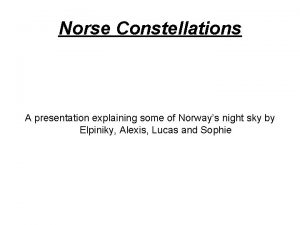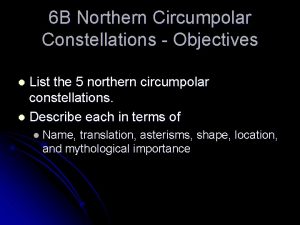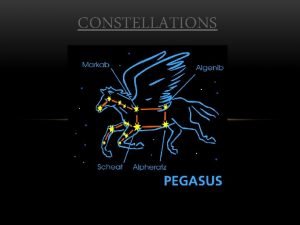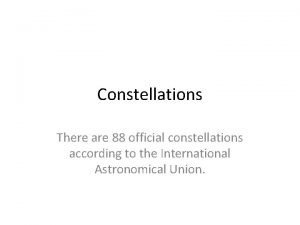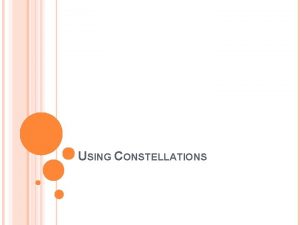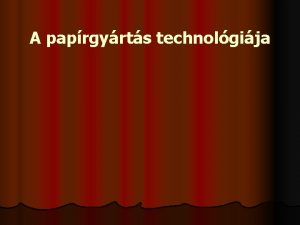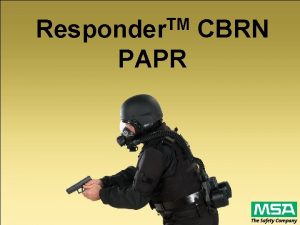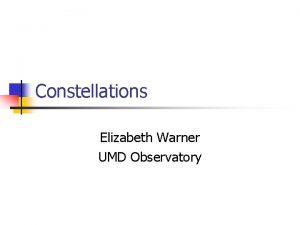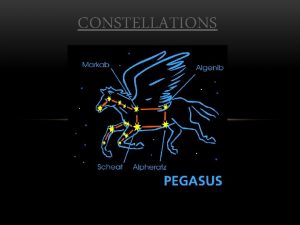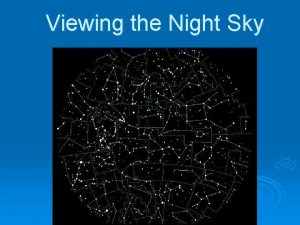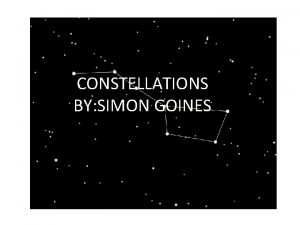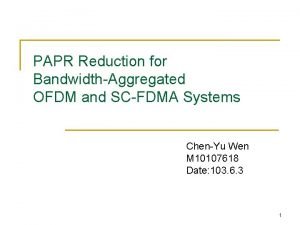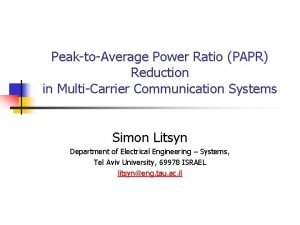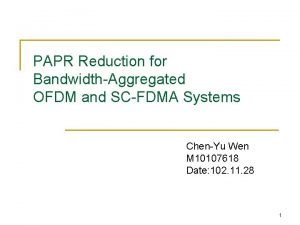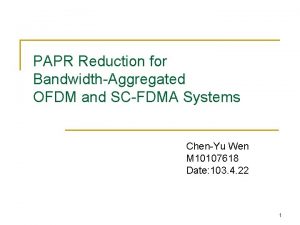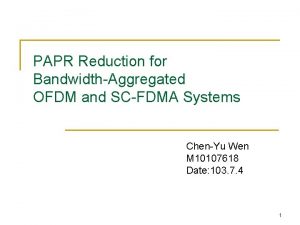Design of Expanded Constellations for PAPR Reduction in































- Slides: 31

Design of Expanded Constellations for PAPR Reduction in OFDM Systems Speaker: Dr. Ali Al-Shaikhi Assistant Professor, EE department Dr. Ali Al-Shaikhi, EE Dept.

1 Outline ¢ ¢ Communication System Demand OFDM l l l ¢ ¢ Basic Principle The Overall System Advantages, Applications, Problems (High PAPR) Techniques Used to Reduce the High PAPR The Proposed Technique to Reduce the High PAPR l l Redial Symmetry Based Technique Constellation Expansion for Alternative Points on: • External Circle • External Square ¢ Application of the Design and Results for: l l ¢ QPSK and 16 QAM (external circle) 64 QAM and 256 QAM (external square) Conclusion Dr. Ali Al-Shaikhi, EE Dept.

2 Communication System ¢ ¢ The demand is increasing for: l Wireless communication l High data rate transmission Under such demand → multipath fading channel Multipath: multiple reflected signals with different phases and times arrivals l The time difference between first and last multipath components is the delay spread distortion l The signal spreads due to the different phases leading to ISI The Best Solution? ! OFDM Dr. Ali Al-Shaikhi, EE Dept.

Orthogonal Frequency Division Multiplexing (OFDM) ¢ ¢ 16 QAM ¢ ¢ 3 Multi-tones modulation The wide bandwidth is divided into a number of small equally spaced frequency bands A subcarrier carrying a portion of the user information is transmitted in each band The subcarriers are overlapping but they are recoverable since they are orthogonal Dr. Ali Al-Shaikhi, EE Dept.

4 OFDM System Dr. Ali Al-Shaikhi, EE Dept.

5 Advantages ¢ ¢ Immunity to delay spread l Symbol duration > channel delay spread Robust against ISI l Simple or no equalization High spectral efficiency l Because of subcarriers overlapping Efficient implementation using FFT l No need for mixers Dr. Ali Al-Shaikhi, EE Dept.

6 Applications ¢ ¢ ¢ ¢ ¢ ADSL and VDSL broadband access via telephone network copper wires IEEE 802. 11 a and 802. 11 g Wireless LANs The Digital audio broadcasting systems EUREKA 147, Digital Radio Mondiale, HD Radio, T-DMB and ISDBTSB Terrestrial digital TV systems DVB-T, DVB-H, T-DMB and ISDB-T IEEE 802. 16 or Wi. Max Wireless MAN IEEE 802. 20 or Mobile Broadband Wireless Access (MBWA) Flash-OFDM cellular system Some Ultra wideband (UWB) systems Power line communication (PLC) Dr. Ali Al-Shaikhi, EE Dept.

7 OFDM Problems ¢ ¢ ¢ Sensitive to Doppler shift Sensitive to frequency synchronization High PAPR Dr. Ali Al-Shaikhi, EE Dept.

8 High PAPR Problem ¢ ¢ The high PAPR causes the peaks to enter the saturation region of the HPA Non-linear amplification by the HPA: l In-band distortion: increases the BER at the receiver l Out-off-band distortion: causes spectral regrowth Dr. Ali Al-Shaikhi, EE Dept.

9 Solutions to High PAPR ¢ ¢ Use HPA that is highly linear l Very expensive Try to operate the HPA in the linear region l Large back off is required l Not efficient use of the HPA Linearize the HPA by using pre-distorters Try to reduce the high PAPR Dr. Ali Al-Shaikhi, EE Dept.

10 PAPR Reduction Techniques ¢ ¢ Clipping/filtering Coding l FEC l Phase Optimization l Partial Transmit Sequence l Selected Mapping (SLM) Probabilistic l Tone Reservation (TR) l Tone Injection (TI) l Active Constellation Extension (ACE) l Error Insertion (EI) PAPR reduction at the expense of: complexity↑, average power↑, BER↑, and data rate↓ Dr. Ali Al-Shaikhi, EE Dept.

11 Tone Injection Dr. Ali Al-Shaikhi, EE Dept.

12 Error Insertion Dr. Ali Al-Shaikhi, EE Dept.

13 Active Constellation Extension Dr. Ali Al-Shaikhi, EE Dept.

Proposed Technique to Reduce the High PAPR ¢ ¢ 14 Radial symmetric mapping provides the most reduction to the high PAPR in OFDM system. Design the constellation in such a way that we take advantage of such location using two form of constellation expansion: l On an external circle: each alternative point is radially symmetric to original point(s). High average power increase especially for high level QAM. l On an external square: each alternative point is radially symmetric to a group of original points. Minimum average power increase. It is good for high level QAM. In both designs, the minimum distance of the constellation is maintained. When we have ambiguity, the alternative signalling points represent recoverable erasures introduced at the transmitter for the purpose of reducing PAPR Dr. Ali Al-Shaikhi, EE Dept.

15 Radial Symmetry Concept Dr. Ali Al-Shaikhi, EE Dept.

16 Test and Statistics QPSK, 64 Tones Dr. Ali Al-Shaikhi, EE Dept.

Alternative Points on External Circle: QPSK and 16 QAM Designs QPSK 17 16 QAM Dr. Ali Al-Shaikhi, EE Dept.

18 Alternative Points on External Square: 256 QAM with 4 -to-1 Mapping Dr. Ali Al-Shaikhi, EE Dept.

19 Framework: Frequency Perturbation Dr. Ali Al-Shaikhi, EE Dept.

20 (1) Search Model: QPSK Dr. Ali Al-Shaikhi, EE Dept.

21 (2) Search Model: QPSK Dr. Ali Al-Shaikhi, EE Dept.

22 CCDF: QPSK and 64 Tones Dr. Ali Al-Shaikhi, EE Dept.

23 CCDF: 16 QAM and 64 Tones (NE) Dr. Ali Al-Shaikhi, EE Dept.

24 CCDF: 16 QAM and 64 Tones (WE) Dr. Ali Al-Shaikhi, EE Dept.

25 CCDF: 256 QAM and 64 Tones Dr. Ali Al-Shaikhi, EE Dept.

Tone Usage and Average Power Increase 26 Dr. Ali Al-Shaikhi, EE Dept.

PSD of the proposed technique: 16 -ary QAM and 64 sub-carriers 27 Dr. Ali Al-Shaikhi, EE Dept.

PSD of the proposed technique: 16 -ary QAM and 64 sub-carriers 28 Dr. Ali Al-Shaikhi, EE Dept.

29 Conclusion ¢ ¢ ¢ ¢ Radial symmetric mapping provides the most reduction to the high PAPR in OFDM system. We designed expanded constellations to exploit the concept of radial symmetry by location the external points on an external square. The minimum distance is maintained and the square is specially suitable for high level QAM since th increase in average power is very small. Erasure decoding was used to deal with the ambiguity when a radial symmetric point corresponds to multiple original points. The average power increase was discussed and found to be relatively small This scheme is very flexible and easily extendable to high level QAM. The proposed method offers tradeoff between PAPR reduction and the system’s ability to recover from errors in the channel. Dr. Ali Al-Shaikhi, EE Dept.

Design of Expanded Constellations for PAPR Reduction in OFDM Systems Thank You For Your Attention Dr. Ali Al-Shaikhi, EE Dept.
 Old papr
Old papr Papr
Papr What constellations can you see all year round
What constellations can you see all year round Viking constellations
Viking constellations Les constellations les plus connues
Les constellations les plus connues Yujin constellations
Yujin constellations List of circumpolar constellations
List of circumpolar constellations Tumblr
Tumblr What are constellations
What are constellations Are constellations capitalized
Are constellations capitalized What are constellations
What are constellations Constellations
Constellations 88 official constellations
88 official constellations Are constellations capitalized
Are constellations capitalized Aquarius water bearer meaning
Aquarius water bearer meaning Five circumpolar constellations
Five circumpolar constellations Fspos
Fspos Novell typiska drag
Novell typiska drag Tack för att ni lyssnade bild
Tack för att ni lyssnade bild Vad står k.r.å.k.a.n för
Vad står k.r.å.k.a.n för Varför kallas perioden 1918-1939 för mellankrigstiden
Varför kallas perioden 1918-1939 för mellankrigstiden En lathund för arbete med kontinuitetshantering
En lathund för arbete med kontinuitetshantering Särskild löneskatt för pensionskostnader
Särskild löneskatt för pensionskostnader Tidbok för yrkesförare
Tidbok för yrkesförare Anatomi organ reproduksi
Anatomi organ reproduksi Vad är densitet
Vad är densitet Datorkunskap för nybörjare
Datorkunskap för nybörjare Tack för att ni lyssnade bild
Tack för att ni lyssnade bild Debatt artikel mall
Debatt artikel mall Autokratiskt ledarskap
Autokratiskt ledarskap Nyckelkompetenser för livslångt lärande
Nyckelkompetenser för livslångt lärande Påbyggnader för flakfordon
Påbyggnader för flakfordon



